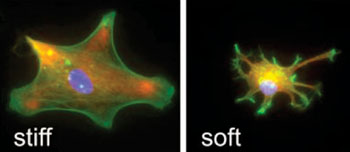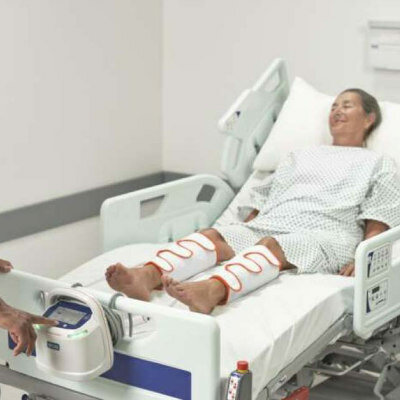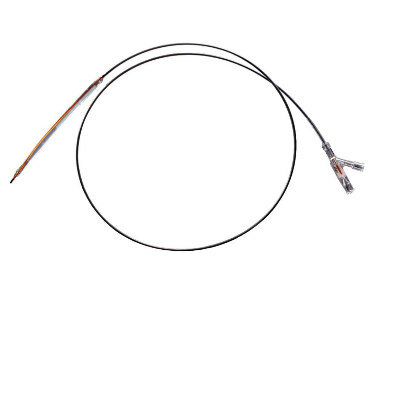Implant Stiffness Leads to Foreign Body Reactions
|
By HospiMedica International staff writers Posted on 25 Feb 2014 |

Image: Cell Morpholgy in relation to surface stiffness (Photo courtesy of the University of Cambridge).
A new study reveals that surgical implant stiffness is a major cause of foreign body reaction (FBR) inflammatory reactions.
Researchers at the University of Cambridge (United Kingdom) implanted composite foreign bodies—one side as soft as neural tissue and the other as stiff as muscle—into rats' brains to examine the impact of an implant's stiffness on the inflammatory process. The researchers found that both primary rat microglial cells and astrocytes responded to the increased contact stiffness by changes in morphology and upregulation of a multitude of inflammatory genes and proteins, with FBR significantly enhanced around the stiff portions of the implant.
The researchers found that the morphologically, the cells around the stiffer substrate were very flat, whereas those grown on the softer substrate looked much more like normal cells found in the brain. According to the researchers, the results suggest that adapting the surface stiffness of electrodes used as neural implants for the stimulation of nervous tissue could minimize adverse reactions and improve biocompatibility. The study was published early online on February 11, 2014, in Biomaterials.
“Brain tissue is as soft as cream cheese; it is one of the softest tissues in the body, and electrodes are orders of magnitude stiffer. The findings could have major implications for the design of implants used in the brain and other parts of the body,” said study coauthor Kristian Franze. “Our results suggest that in the short term, simply coating existing implants with materials that match the stiffness of the tissue they are being implanted into will help reduce foreign body reactions.”
Implant FBR in the brain can cause the implants to be encapsulated by reactive tissue, which in the CNS consists mainly of microglial cells and astrocytes, which are surrounded by extracellular matrix (ECM). The reactive process, which starts with the activation of glial cells, can damage local neurons, and the subsequent dendritic retraction and neuronal death may contribute to a gradual decline in the function of implanted electrodes.
Related Links:
University of Cambridge
Researchers at the University of Cambridge (United Kingdom) implanted composite foreign bodies—one side as soft as neural tissue and the other as stiff as muscle—into rats' brains to examine the impact of an implant's stiffness on the inflammatory process. The researchers found that both primary rat microglial cells and astrocytes responded to the increased contact stiffness by changes in morphology and upregulation of a multitude of inflammatory genes and proteins, with FBR significantly enhanced around the stiff portions of the implant.
The researchers found that the morphologically, the cells around the stiffer substrate were very flat, whereas those grown on the softer substrate looked much more like normal cells found in the brain. According to the researchers, the results suggest that adapting the surface stiffness of electrodes used as neural implants for the stimulation of nervous tissue could minimize adverse reactions and improve biocompatibility. The study was published early online on February 11, 2014, in Biomaterials.
“Brain tissue is as soft as cream cheese; it is one of the softest tissues in the body, and electrodes are orders of magnitude stiffer. The findings could have major implications for the design of implants used in the brain and other parts of the body,” said study coauthor Kristian Franze. “Our results suggest that in the short term, simply coating existing implants with materials that match the stiffness of the tissue they are being implanted into will help reduce foreign body reactions.”
Implant FBR in the brain can cause the implants to be encapsulated by reactive tissue, which in the CNS consists mainly of microglial cells and astrocytes, which are surrounded by extracellular matrix (ECM). The reactive process, which starts with the activation of glial cells, can damage local neurons, and the subsequent dendritic retraction and neuronal death may contribute to a gradual decline in the function of implanted electrodes.
Related Links:
University of Cambridge
Latest Surgical Techniques News
- Robotic Assistant Delivers Ultra-Precision Injections with Rapid Setup Times
- Minimally Invasive Endoscopic Surgery Improves Severe Stroke Outcomes
- Novel Glue Prevents Complications After Breast Cancer Surgery
- Breakthrough Brain Implant Enables Safer and More Precise Drug Delivery
- Bioadhesive Sponge Stops Uncontrolled Internal Bleeding During Surgery
- Revolutionary Nano Bone Material to Accelerate Surgery and Healing
- Superior Orthopedic Implants Combat Infections and Quicken Healing After Surgery
- Laser-Based Technique Eliminates Pancreatic Tumors While Protecting Healthy Tissue
- Surgical Treatment of Severe Carotid Artery Stenosis Benefits Blood-Brain Barrier
- Revolutionary Reusable Duodenoscope Introduces 68-Minute Sterilization
- World's First Transcatheter Smart Implant Monitors and Treats Congestion in Heart Failure
- Hybrid Endoscope Marks Breakthrough in Surgical Visualization
- Robot-Assisted Bronchoscope Diagnoses Tiniest and Hardest to Reach Lung Tumors
- Diamond-Titanium Device Paves Way for Smart Implants that Warn of Disease Progression
- 3D Printable Bio-Active Glass Could Serve as Bone Replacement Material
- Spider-Inspired Magnetic Soft Robots to Perform Minimally Invasive GI Tract Procedures
Channels
Critical Care
view channel
CPR Guidelines Updated for Pediatric and Neonatal Emergency Care and Resuscitation
Cardiac arrest in infants and children remains a leading cause of pediatric emergencies, with more than 7,000 out-of-hospital and 20,000 in-hospital cardiac arrests occurring annually in the United States.... Read more
Ingestible Capsule Monitors Intestinal Inflammation
Acute mesenteric ischemia—a life-threatening condition caused by blocked blood flow to the intestines—remains difficult to diagnose early because its symptoms often mimic common digestive problems.... Read more
Wireless Implantable Sensor Enables Continuous Endoleak Monitoring
Endovascular aneurysm repair (EVAR) is a life-saving, minimally invasive treatment for abdominal aortic aneurysms—balloon-like bulges in the aorta that can rupture with fatal consequences.... Read more
Wearable Patch for Early Skin Cancer Detection to Reduce Unnecessary Biopsies
Skin cancer remains one of the most dangerous and common cancers worldwide, with early detection crucial for improving survival rates. Traditional diagnostic methods—visual inspections, imaging, and biopsies—can... Read morePatient Care
view channel
Revolutionary Automatic IV-Line Flushing Device to Enhance Infusion Care
More than 80% of in-hospital patients receive intravenous (IV) therapy. Every dose of IV medicine delivered in a small volume (<250 mL) infusion bag should be followed by subsequent flushing to ensure... Read more
VR Training Tool Combats Contamination of Portable Medical Equipment
Healthcare-associated infections (HAIs) impact one in every 31 patients, cause nearly 100,000 deaths each year, and cost USD 28.4 billion in direct medical expenses. Notably, up to 75% of these infections... Read more
Portable Biosensor Platform to Reduce Hospital-Acquired Infections
Approximately 4 million patients in the European Union acquire healthcare-associated infections (HAIs) or nosocomial infections each year, with around 37,000 deaths directly resulting from these infections,... Read moreFirst-Of-Its-Kind Portable Germicidal Light Technology Disinfects High-Touch Clinical Surfaces in Seconds
Reducing healthcare-acquired infections (HAIs) remains a pressing issue within global healthcare systems. In the United States alone, 1.7 million patients contract HAIs annually, leading to approximately... Read moreHealth IT
view channel
Printable Molecule-Selective Nanoparticles Enable Mass Production of Wearable Biosensors
The future of medicine is likely to focus on the personalization of healthcare—understanding exactly what an individual requires and delivering the appropriate combination of nutrients, metabolites, and... Read moreBusiness
view channel
Philips and Masimo Partner to Advance Patient Monitoring Measurement Technologies
Royal Philips (Amsterdam, Netherlands) and Masimo (Irvine, California, USA) have renewed their multi-year strategic collaboration, combining Philips’ expertise in patient monitoring with Masimo’s noninvasive... Read more
B. Braun Acquires Digital Microsurgery Company True Digital Surgery
The high-end microsurgery market in neurosurgery, spine, and ENT is undergoing a significant transformation. Traditional analog microscopes are giving way to digital exoscopes, which provide improved visualization,... Read more
CMEF 2025 to Promote Holistic and High-Quality Development of Medical and Health Industry
The 92nd China International Medical Equipment Fair (CMEF 2025) Autumn Exhibition is scheduled to be held from September 26 to 29 at the China Import and Export Fair Complex (Canton Fair Complex) in Guangzhou.... Read more












